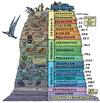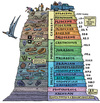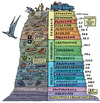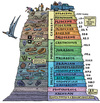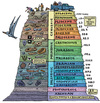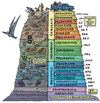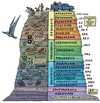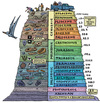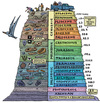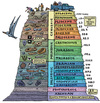Exam 2 Flashcards
Types of Differential Stress
- Compressional 2. Tensional 3. Shear
Elastic Deformation
Reversible change
Ductile Deformation
Irreversible change
Fracture
Breaking
Yield strength / elastic limit
Stress at which deformation becomes permanent
What is the bonding b/w O and Si in the Si-O tetrahedral in Quartz?
Covalent
Ductile substance
changes shape
Rocks are easier to melt when __
wet
Ductile deformation also known as:
folding
Metamorphic rock that has begun to melt?
Migmatite
Folding happens at:
- Subduction zones 2. Collision zones
Brittle Deformation also known as
Faulting
Creep
Stress released continuously
Faulting - wall that stays above
Footwall
Faulting - wall that sinks
Hanging wall
Types of Faulting
- Normal 2. Reverse/Thrust 3. Strike-slip/Transform
Regional Extension
Type of faulting with Horsts and Grabens
Horst
Footwall in regional extension (above)
Graben
Rift valley in regional extension
Normal faulting happens due to
Stretching
Reverse/Thrust faulting happens due to
Compression
Thrust faulting
Shallow angle
Reverse faulting
Steep angle
Normal faulting happens at:
Divergent boundaries
Reverse/thrust happens at:
Convergent boundaries
“Stick slip” motion
Locked faulting builds pressure
Liquifaction happens in ________
Siliciclastic areas
Focus of earthquake
Where fault ruptures
Epicenter
Point directly above focus (on surface)
P-Wave
Primary wave (Pressure waves)
S-Wave
Shear wave (Secondary waves)
Surface waves are the _______ to arrive and cause the ____ damage
Last to arrive. Most
____ waves are analogous to sound waves
P-
Need ___ seismic readings to find epicenter
3
Richter scale
Logarithmic: 1-9
Cratons
Stable interiors that have not collided w/ other plates for past 1 B years
Ororgenic belts aka
Mountain belts
Fans aka
Clastic wedges
Indian plate movement
15cm / yr
New Madrid Fault
Ancient fault system, altered Mississippi river
Himalayas have _______ despite continental collision setting
Deep quakes
Obduction
Slivers of oceanic sediments get uplifted during subduction –> Ophiolites
Subduction evidence?
Andesite, intruded batholiths
Young oceanic crust
- hot - high - thin - buoyant
Old oceanic crust
- cold - low - thick - not buoyant
Cause of Appalachians
Collision of Gondwana and Laurussia = PANGEA
Appalachians stay high b/c _____
have deep root
Names of Indian ocean fans
Bengal, Nicobar
William “Strata” Smith
- Land surveyor - Noticed earth layering - Made first geological maps
First Geologists
James Hutton & Charles Lyell
Principles of Geology (Hutton & Lyell)
- Strata originally horizontal - Principles of superposition - Cross cutting relations
Principle of Superpositiion
Young-top, Old-bottom
Cross Cutting Relations
Rock that cuts across another is younger
Uncomformity
Erosional surface where part of rock record is missing
Angular uncomformity
Tilted sediment, covered by flat sediment
Granite Formation b/w
Archean & Proterozoic
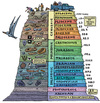
Granite formation happened ____ BYA
2.5
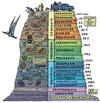
Earliest life ___ BYA
3.6
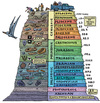
Cambrian explosion b/w
Proterozoic & Paleozoic
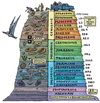
Cambrian explosion happened ____ MYA
542
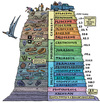
First mass extinction b/w
Paleozoic & Mesozoic

1st mass extinction happened ____ MYA
250

____% of species extinct in first mass extinction
90-96
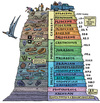
2nd Mass Extinction happened b/w
Mesozoic & Cenozoic

2nd Mass Extinction happened ____ MYA
66

Cambrian Explosion top critters
- Trilobytes - Brachiopods - Cephalopods







